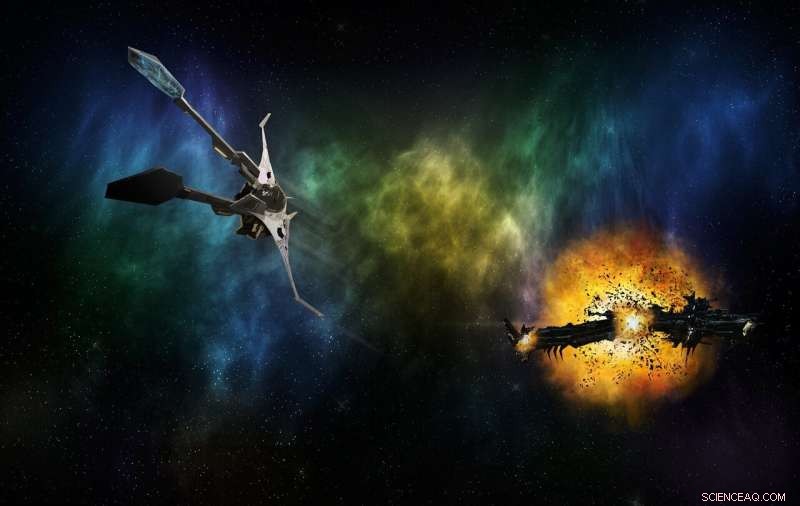 p Crédito:Pixabay / CC0 Public Domain
p Crédito:Pixabay / CC0 Public Domain
p Filmes espaciais de ficção científica podem fazer um trabalho ruim em educar as pessoas sobre o espaço. Nos filmes, pilotos de tiro quente dirigem suas naves espaciais de duelo através do espaço como se estivessem voando através de uma atmosfera. Eles inclinam-se, giram e executam loops e rolos, talvez dê uma volta rápida de Immelman, como se estivessem sujeitos à gravidade da Terra. Isso é realista? p Não.
p Na realidade, uma batalha espacial provavelmente terá uma aparência muito diferente. Com uma presença cada vez maior no espaço, e o potencial para conflitos futuros, é hora de pensar sobre como seria uma batalha espacial real?
p A Aerospace Corporation, sem fins lucrativos, acha que é hora de considerar como seria uma batalha espacial real. A Dra. Rebecca Reesman do Centro de Política e Estratégia Espacial da Aerospace Corporation e seu colega James R. Wilson escreveram um artigo sobre o tema das batalhas espaciais, intitulado "The Physics of Space War:How Orbital Dynamics Constrain Space-to-Space Engagements."
p Se os assuntos humanos do passado indicam o futuro, então a militarização do espaço prosseguirá. Apesar de se falar em manter o espaço pacífico, e apesar dos tratados que dizem o mesmo. Portanto, é importante que, à medida que mais nações aumentam sua presença no espaço, e como uma competição por recursos começa a causar problemas, que a conversa em torno do conflito espacial tome um rumo realista.
p É o caso que os autores fazem na introdução de seu artigo. “Enquanto os Estados Unidos e o mundo discutem a possibilidade de um conflito se estender ao espaço, é importante ter uma compreensão geral do que é fisicamente possível e prático. Cenas de Star Wars, livros e programas de TV retratam um mundo muito diferente do que provavelmente veremos nos próximos 50 anos, se alguma vez, dadas as leis da física. "
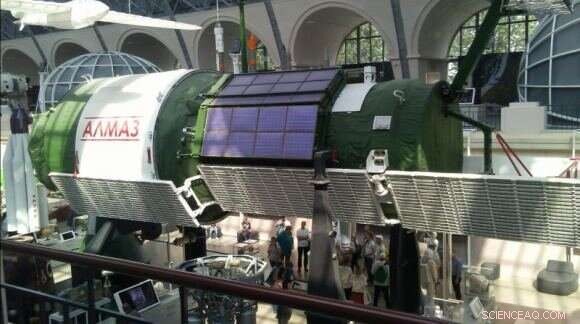 p Uma tripulação da estação espacial Almaz soviética no Centro de Cosmonáutica e Aviação de Moscou. A Rússia projetou vários tipos de satélites militares e estações espaciais, alguns armados com uma metralhadora, antes de abandonar a ideia por ser muito cara. Crédito:Por Pulux11 - Obra própria, CC BY-SA 4.0
p Uma tripulação da estação espacial Almaz soviética no Centro de Cosmonáutica e Aviação de Moscou. A Rússia projetou vários tipos de satélites militares e estações espaciais, alguns armados com uma metralhadora, antes de abandonar a ideia por ser muito cara. Crédito:Por Pulux11 - Obra própria, CC BY-SA 4.0
p Nunca houve uma batalha no espaço ainda. Mas tem havido alguma atividade de teste de armas. A China está trabalhando em armas anti-satélite e testou um míssil anti-satélite. A Índia também. A Rússia também está trabalhando em capacidades anti-satélite, e os EUA estão fazendo o mesmo. Os EUA destruíram um de seus próprios satélites com um míssil em 1985.
p Provavelmente, esta é apenas a ponta do iceberg no que diz respeito a futuros conflitos no espaço. Nenhuma dessas atividades anti-satélite envolveu pessoas viajando em espaçonaves, e pode nunca haver necessidade de espaçonaves militares com tripulação, de acordo com o jornal. "Os combates espaço-espaço em um conflito moderno seriam travados apenas com veículos sem tripulação controlados por operadores em terra e fortemente restringidos pelos limites que a física impõe ao movimento no espaço."
p Nos primeiros dias da Era Espacial, enquanto a Guerra Fria ainda estava ocorrendo, as superpotências imaginaram que o conflito no espaço seria em grande parte uma extensão dos conflitos terrestres. Os soviéticos até projetaram estações espaciais armadas com metralhadoras para se defender contra ataques de astronautas americanos. Os EUA trabalharam em ideias semelhantes.
p Mas os avanços tecnológicos significaram que esses esforços foram abandonados em favor de satélites sem rosca. "Eventualmente, ambos os programas vacilaram. Em vez de, melhorias na tecnologia e transmissão de dados - os mesmos desenvolvimentos que em última análise sustentam nossa vida moderna conectada - tornaram possíveis satélites que executam as mesmas funções militares previstas para os programas tripulados anteriores. " o espaço é dominado por satélites, com apenas a ISS hospedando humanos.
p Este será o futuro, de acordo com o jornal. Pelos próximos 50 anos ou mais, quaisquer conflitos no espaço envolverão ataques a satélites. Mas nem tudo será um ataque direto. Os autores descrevem quatro objetivos em um ataque espacial:
p
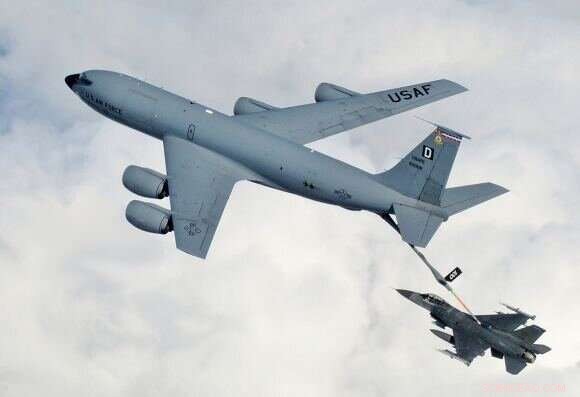 p As batalhas espaciais provavelmente serão entre satélites, e reabastecer não será uma opção. Nesta imagem, um F-16 está reabastecendo de um KC-135 Stratotanker. Crédito:Pela Força Aérea dos EUA
p As batalhas espaciais provavelmente serão entre satélites, e reabastecer não será uma opção. Nesta imagem, um F-16 está reabastecendo de um KC-135 Stratotanker. Crédito:Pela Força Aérea dos EUA
- Engane um inimigo para que ele reaja de maneiras que ferem seus interesses.
- Perturbe, negar, ou degradar a capacidade de um inimigo de usar uma capacidade espacial, temporária ou permanentemente.
- Destrua completamente uma capacidade baseada no espaço.
- Impedir ou defender contra um adversário de contra-ataque, tanto no espaço quanto na Terra.
p Os satélites se movem de maneira muito previsível. Eles se movem rapidamente, mas é relativamente fácil prever sua posição futura e interceptá-los, em muitos casos. Alguns satélites podem alterar sua altura orbital, mas eles não têm capacidade de manobra real e quase nenhuma maneira de evitar um ataque.
p "Para descrever como a física restringiria os engajamentos espaço-a-espaço, este artigo descreve cinco conceitos-chave:os satélites se movem rapidamente, satélites se movem de forma previsível, o espaço é grande, tempo é tudo, e os satélites manobram lentamente. "
p O voo pela atmosfera da Terra não é exatamente simples, mas é muito intuitivo. Mas no espaço, é completamente diferente e não é exatamente chamado de vôo. Sem atmosfera e baixa gravidade, as coisas são muito diferentes. "O movimento no espaço é contra-intuitivo para aqueles acostumados a voar dentro da atmosfera da Terra e a chance de reabastecer, "escrevem os autores.
p "Enfrentamentos espaço-espaço seriam deliberados e provavelmente se desdobrariam lentamente porque o espaço é grande e as espaçonaves só podem escapar de seus caminhos previsíveis com grande esforço. Além disso, ataques a recursos espaciais exigiriam precisão porque espaçonaves e até mesmo armas baseadas em solo podem atacar alvos no espaço somente após cálculos complexos serem determinados em um domínio altamente projetado. "Não haveria nenhum quadro de pilotos de caça em espera, esperando para embaralhar e lançar rapidamente. Em vez de, uma batalha espacial envolvendo satélites é mais um exercício matemático.
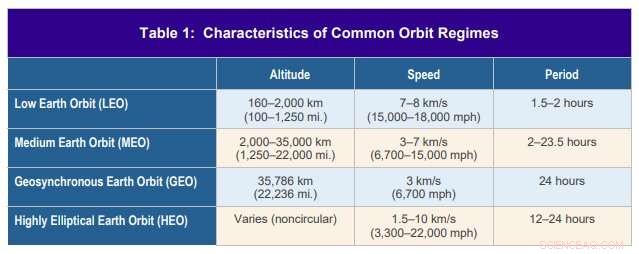 p As órbitas do satélite são previsíveis e não dependem da massa do satélite. Crédito:Reesman e Wilson 2020.
p As órbitas do satélite são previsíveis e não dependem da massa do satélite. Crédito:Reesman e Wilson 2020.
p "This is true because physics puts constraints on what happens in space. Only by mastering these constraints can other questions such as how to fight and, mais importante, when and why to fight a war in space, be explored, " eles escrevem.
p A satellite's orbit is predictable because of the relationship between speed, altitude and the orbit's shape. At lower altitudes, satellites can experience atmospheric drag. Também, the Earth isn't a perfect sphere. But those factors can be accounted for in an attack. "To deviate from their prescribed orbit, satellites must use an engine to maneuver. This contrasts with airplanes, which mostly use air to change direction; the vacuum of space offers no such option, " eles escrevem.
p The sheer volume of space is also a factor in a space battle. "The volume of space between LEO and GEO is about 200 trillion cubic kilometers (50 trillion cubic miles). That is 190 times bigger than the volume of Earth."
p So tracking satellites accurately in that volume of space will be a continuous challenge, since some will be designed to be undetected. But that's not impossible; satellites are regularly tracked. And since they're not very maneuverable, once a satellite's orbit is detected, monitors can keep track of its trajectory.
p The sheer volume of space also means that most space battles would be very short-lived. There won't be any dogfights. "Space is big, which means that a space-to-space engagement is not going to be both intense and long. It can only be one or the other:either a short, intense use of a lot of Delta V for big effect or long, deliberate use of Delta V for smaller or persistent effects."
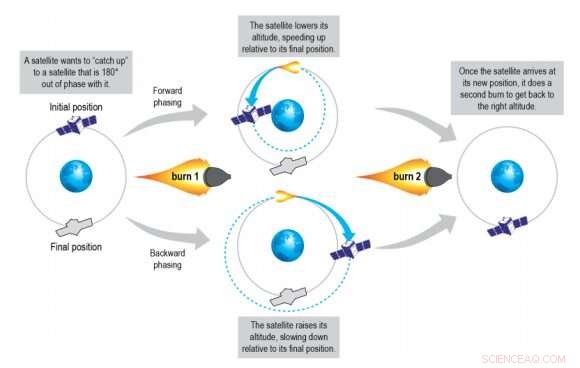 p Satellites change their position in their orbit with phasing maneuvers. Any time a satellite raises its orbit, it slows down and appears to be moving backward in relation to its prior orbit and altitude. This is how a satellite can “catch up” to another satellite. Credit:Reesman and Wilson 2020
p Satellites change their position in their orbit with phasing maneuvers. Any time a satellite raises its orbit, it slows down and appears to be moving backward in relation to its prior orbit and altitude. This is how a satellite can “catch up” to another satellite. Credit:Reesman and Wilson 2020
p Delta V is a change in velocity, and that requires fuel or propellant. But most satellites don't have the capability to change their velocity, and the few that might are severely fuel-limited.
p "Operators of an attack satellite may spend weeks moving a satellite into an attack position during which conditions may have changed that alter the need for or the objective of the attack." And if the defending satellite is able to only slightly change its own path in response to an attack, then the attacking satellite may not have the capability or the fuel to change its own path to intercept it.
p The authors also point out that timing is everything. Even if an attacking satellite can orient itself into the same orbital path as its target, there's still no guarantee of proximity.
p "The nature of conflict often requires two competing weapons systems to get close to one another, " the report says. The authors use the example of an aircraft carrier needing to get close to its target, and another of jet fighters that also need to be close to each other. The same thing is true of satellites in space.
p "Getting two satellites to the same altitude and the same plane is straightforward (though time and ?V consuming), but that does not mean they are yet in the same spot. The phasing—current location along the orbital trajectory—of the two satellites must also be the same. Since speed and altitude are connected, getting two satellites in the same spot is not intuitive." Instead, it takes perfect timing and meticulous preparation.
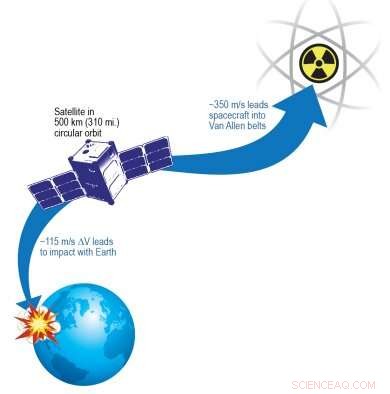 p If a satellite performs a forward phasing maneuver with a first burn of 115 m/s or more of ?V, it will reenter Earth’s atmosphere and burn up. De forma similar, if the satellite performs a backward phasing maneuver with a first burn of 350 m/s or more of ?V, it will experience high radiation in the Van Allen belts. These two facts create natural bounds for how quickly a satellite can maneuver in LEO (500 km or 310 mi.). Credit:Reesman and Wilson 2020
p If a satellite performs a forward phasing maneuver with a first burn of 115 m/s or more of ?V, it will reenter Earth’s atmosphere and burn up. De forma similar, if the satellite performs a backward phasing maneuver with a first burn of 350 m/s or more of ?V, it will experience high radiation in the Van Allen belts. These two facts create natural bounds for how quickly a satellite can maneuver in LEO (500 km or 310 mi.). Credit:Reesman and Wilson 2020
p The authors also discuss another method of approaching a target called "plane matching, " A satellite maneuvers itself so that its orbital plane is aligned with a target. That has the advantage of allowing the attacker to dictate the time of the engagement. "By not initiating threatening maneuvers immediately, an attacker may try to seem harmless while waiting for an optimal time to attack, " the authors explain.
p But none of these maneuvers happen quickly. "The physics of space dictate that kinetic space-to-space engagements be deliberate with satellites maneuvering for days, if not weeks or months, beforehand to get into position to have meaningful operational effects, " they write. But it can still be done.
p And once the interception has been set up, "…many opportunities can arise to maneuver close enough to engage a target quickly."
p There are natural limits to how maneuvering satellites in LEO can do. Por um lado, some phasing maneuvers can send the satellite into the Earth's atmosphere where it will be burned up. No outro, it could be sent too far away from LEO, into the Van Allen Belts. So there are constraints on a satellite's maneuverability.
p Satellites in geostationary orbits maintain the same relative position over Earth, so some of the mechanics of attacking and defending are different. Mas acima de tudo, the same constraints are still in place. It takes time and energy to maneuver in space, regardless of the type of orbit.
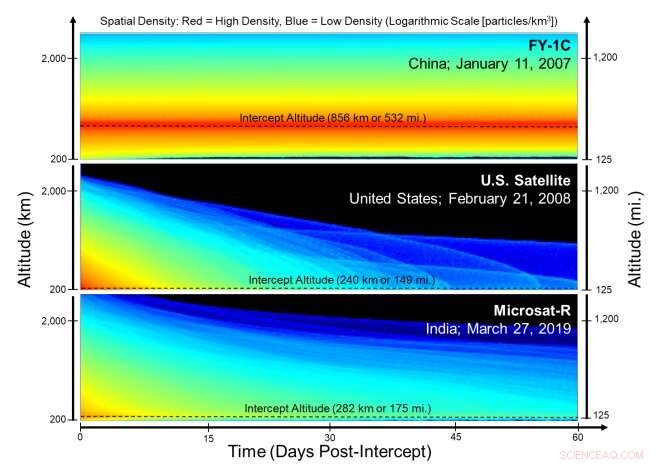 p The density of debris is compared at different altitudes as a function of time after the ASAT intercepted (made contact with and destroyed) the target satellite. The Chinese test happened at a much higher altitude (856 km or 532 mi.) than the other two, creating long-lasting debris. Credit:Reesman and Wilson, 2020
p The density of debris is compared at different altitudes as a function of time after the ASAT intercepted (made contact with and destroyed) the target satellite. The Chinese test happened at a much higher altitude (856 km or 532 mi.) than the other two, creating long-lasting debris. Credit:Reesman and Wilson, 2020
p But orbital and maneuverability considerations are only a part of what the report addresses.
p The authors go on to discuss the types of attacks that can take place. Collisions, projectiles, and electronic jamming or disruption are covered in the paper. Each type has its own considerations and preparations.
p But the authors also discuss the aftermath of some successful attacks:complications arising from debris. Additional debris could end up damaging other unintentional targets, like the attacker's own satellites or those of a neutral nation. There have been three successful anti-satellite attacks:one by China, one by the U.S., e Índia. The authors prepared a graphic to show the debris from each one.
p The debris cloud from an attack is denser immediately after the attack and spreads out quickly. Even though debris density is lowered quickly, the debris spreads out over a larger area and is still hazardous.
p The paper is a clear presentation of all of the difficulties with space battles and how much different they would be compared to air-to-air battles. But some other considerations that are still important are outside its scope.
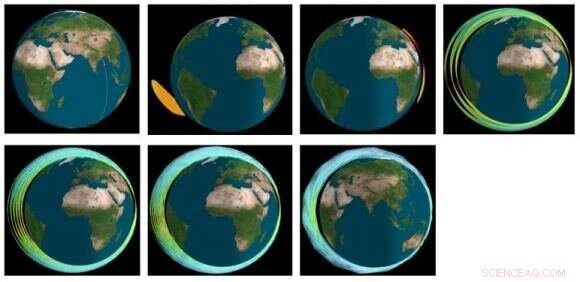 p This image shows the debris cloud from the Indian ASAT in 2019. The panels show the cloud at 5 min., 45 min., 90 min., 1 day, 2 days, 3 days, and 6 days after the attack. Credit:Reesman and Wilson 2020
p This image shows the debris cloud from the Indian ASAT in 2019. The panels show the cloud at 5 min., 45 min., 90 min., 1 day, 2 days, 3 days, and 6 days after the attack. Credit:Reesman and Wilson 2020
p What happens when one nation deduces that their satellites are about to be attacked? They won't sit on their thumbs. They'll likely denounce, threaten, and even retaliate here on Earth. A space attack could end up being a flashpoint for another terrestrial war.
p There could end up being an arms race in space, where nations compete to outspend each other on space weaponry and other technology. That's a huge strain on resources for a world that should be focused on meeting the challenge of climate change.
p E, where does it all end? War in orbit? War on the moon? War on Mars? When will humanity figure it out and just stop?
p One day, maybe, there'll be a final war before we give it all up. But that won't likely be in the next 50 years.
p And if there is a war in the next 50 years or so, it may involve satellites, and it may look a lot like how the authors of this report have laid it out:slow, calculated, and deliberate.







